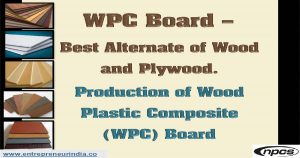
WPC Board – Best Alternate of Wood and Plywood. Production of Wood Plastic Composite (WPC) Board
WPC is made from Plastic and wood. The percentage of plastic in WPC is more than 80%, which makes it 100% Water Proof Termite Proof. WPC can be used just like a plywood. Even all the tools and screws are same as plywood tools screws.
Applications:
- Modular kitchen (best fit for free water conditions)
- Kitchen cabinets
- Post formed components
- Modular office furniture
- House hold furniture
- Doors
- Windows
- Bathroom vanities
- Bathroom doors
- Back panelling
- Partitioning systems
- Exterior coverings
- Table tops
- Advertisement boards
WPC is a highly durable and secure material used for construction purposes. It is a blend of wood fibre/ wood flour and thermoplastics. The WPC boards are also prepared from inorganic fillers and plastic composites. Wood plastic composite is also used as a strong and high end flooring option. The WPC doors are used for flooring, decking, railings, fences, landscaping, windows, doors, outdoor or indoor cladding, for making door and windows frames, for preparing strong and designer fuby mixing the ground rniture etc.
The WPC boards are prepared by mixing the ground wood elements and heated thermoplastic resins while moulding it into a required shape. Even recycles thermoplastics are used for preparing solid and useful WPC profiles.
WPC Board Advantages:
- WPC boards come with assured quality. These boards consist of stabilizing agents, modifiers, foaming agents and such elements that require strict mixing ratio. Due to the perfect blend of high quality materials, WPC boards become a high quality material.
- WPC can be moulded into different shapes and sizes. If you are looking for a designer door or window made from WPC, it is possible as WPC gives a very rich look and freshest polishing. This is the reason it is used for doors, windows and home furnishing.
- WPC material is highly fire resistant. It provides fire protection and keeps your furnishings safe.
- The WPC material undergoes modern and high end surface treatment through paint or thermal transfer which makes the WPC profiles, doors or flooring look flourishing. The proficient surface treatment not only provides a unique look to the WPC boards but also gives a ravishing look to the boards.
- It is an environment friendly material which is safe to use. It remains untouched and unaffected from climatic conditions and provides security from water, fire and chemicals.
- It is a promising and cost effective substitute to plywood.
These boards are covering a large application area starting from interior grade boards being used for making furniture, kitchen cabinets, kitchen shutters. Taking further, these boards are being used for making temporary shelters for government housing projects, construction site pavilions/shelters, low cost housing projects and other road and building projects.
Market Outlook
WPC boards is achieving a good absorbency amongst plywood and natural wooden boards.
The wood-plastic composites market is projected to reach USD 5.84 billion by 2021, at a CAGR of 12.4% from 2016 to 2021. Based on application, the wood-plastic composites market has been segmented into building & construction products, automotive components, industrial & consumer goods, and others. Based on type, the market has been segmented into polyethylene (PE), polyvinylchloride (PVC), polypropylene (PP), and others.
The building & construction products segment is expected to be the largest consumer of PE and PVC wood-plastic composites, followed by automotive components segment where wood-plastic composites are used for manufacturing lightweight automotive components. In this study, 2015 has been considered the base year and 2016-2021 as the forecast period to estimate the wood-plastic composite market size.
U.S. Wood Plastic Composite Market Size, By Type, 2014-2025 (USD Billion)
Building and construction is one of the most important applications for WPC and accounted for the largest market share in 2017. Rising demand for aesthetically appealing flooring and furniture solutions across the world is expected to aid segment growth over the forecast period.
Global Wood Plastic Composite Market Share, By Application, 2017 (%)
The expanding application scope in decking and fencing applications is expected to drive demand for the product in the construction industry. Growing demand for wood plastic composite as a low cost and environmentally friendly substitute to plastic and steel components in construction applications is expected to drive market growth. The improved properties offered by the wood plastic composites, such as better recyclability, thermal stability, and stiffness, are expected to open new avenues for the industry growth over the next eight years. Moreover, its rising use in street constructions and landscaping owing to the noise barrier properties offered by the product is likely to propel demand.
The industry is expected to witness significant growth over the forecast period owing to the fluctuating petrochemical prices and intensified environmental concerns. Wood processing and plastic manufacturers are expected to shift towards wood plastic composite manufacturing owing to similar manufacturing technology, as well lower production cost. Furthermore, plastic manufacturers are expected to shift more rapidly owing to technical know-how.
The major applications of wood-plastic composites are building & construction products, followed by automotive components. In building & construction application, wood-plastic composites are widely used in decking, molding & sliding, and fencing. Growing demand for high-performance, low-maintenance, and low-cost building products that are eco-friendly and offer maintenance-free properties is expected to fuel the global demand for wood-plastic composites in coming years.
Rising application scope in decking and fencing applications is expected to drive demand for the product in the construction industry. Growing demand for wood plastic composite as a low cost and environment-friendly substitute to plastic and steel components in construction applications is expected to drive the market growth.
See more